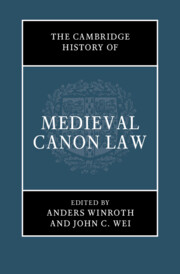Book contents
- The Cambridge History of Medieval Canon Law
- The Cambridge History of Medieval Canon Law
- Copyright page
- Contents
- Figures
- Maps
- Tables
- Contributors
- Acknowledgments
- Abbreviations
- Medieval Canon Law: Introduction
- Part I The History of Medieval Canon Law
- Part II The Sources and Dissemination of Medieval Canon Law
- Part III Doctrine and Society
- Iudicium
- Clerus
- 18 Ecclesiastical Property, Tithes, Spiritualia
- 19 The Law of Benefices
- 20 Religious Life
- 21 The Sacraments of Baptism, Confirmation, and the Eucharist
- 22 Confession, Penance, and Extreme Unction
- 23 Saints and Relics
- Conubium
- Crimen
- Conclusion
- Bibliography of Primary Sources
- Index
- References
18 - Ecclesiastical Property, Tithes, Spiritualia
from Clerus
Published online by Cambridge University Press: 13 January 2022
- The Cambridge History of Medieval Canon Law
- The Cambridge History of Medieval Canon Law
- Copyright page
- Contents
- Figures
- Maps
- Tables
- Contributors
- Acknowledgments
- Abbreviations
- Medieval Canon Law: Introduction
- Part I The History of Medieval Canon Law
- Part II The Sources and Dissemination of Medieval Canon Law
- Part III Doctrine and Society
- Iudicium
- Clerus
- 18 Ecclesiastical Property, Tithes, Spiritualia
- 19 The Law of Benefices
- 20 Religious Life
- 21 The Sacraments of Baptism, Confirmation, and the Eucharist
- 22 Confession, Penance, and Extreme Unction
- 23 Saints and Relics
- Conubium
- Crimen
- Conclusion
- Bibliography of Primary Sources
- Index
- References
Summary
In 1910, Emile Lesne published the first volume of his monumental Histoire de la propriété ecclésiastique en France (“History of Ecclesiastical Property in France”), the last volume of which appeared posthumously in 1943. Lesne’s work remains a formidable mine of texts and examples. It also reveals much about the time it was written. A priest and historian, Lesne had his career in Lille, in the new Catholic university whose rector he became in 1919. He was not only a historian of Church property, but also active in its administration. The splendid university building of the Faculté libre of Lille was a fine example of the tangible success of the Catholic Church, which headed a formidable educational network, in the Europe of the second half of the nineteenth century. Yet in 1905 a law strictly separating Church and state set off a crisis of Church property in France that was only settled by a negotiated compromise painfully worked out with the Vatican in 1924.
- Type
- Chapter
- Information
- The Cambridge History of Medieval Canon Law , pp. 345 - 367Publisher: Cambridge University PressPrint publication year: 2022

